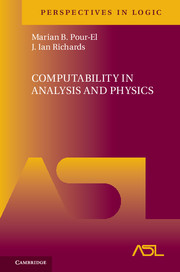Book contents
- Frontmatter
- Preface to the Series Perspectives in Mathematical Logic
- Authors' Preface
- Contents
- Maps
- Introduction
- Prerequisites from Logic and Analysis
- Part I Computability in Classical Analysis
- Part II The Computability Theory of Banach Spaces
- Part III The Computability Theory of Eigenvalues and Eigenvectors
- Addendum: Open Problems
- Bibliography
- Subject Index
Introduction
Published online by Cambridge University Press: 24 March 2017
- Frontmatter
- Preface to the Series Perspectives in Mathematical Logic
- Authors' Preface
- Contents
- Maps
- Introduction
- Prerequisites from Logic and Analysis
- Part I Computability in Classical Analysis
- Part II The Computability Theory of Banach Spaces
- Part III The Computability Theory of Eigenvalues and Eigenvectors
- Addendum: Open Problems
- Bibliography
- Subject Index
Summary
This book deals with computable analysis. The subject, as its name suggests, represents a marriage between analysis and physics on the one hand, and comput-ability on the other. Computability, of course, brings to mind computers, which are playing an ever larger role in analysis and physical theory. Thus it becomes useful to know, at least theoretically, which computations in analysis and physics are possible and which are not.
In this book, we attempt to develop a coherent framework for solving problems in this area. We will see that a variety of questions in computable analysis can be answered within this framework. For example, we will deal with computability for classical analysis, mathematical physics, Hilbert and Banach spaces, bounded and unbounded linear operators, eigenvalues and eigenvectors, and a variety of other topics. All of these are dealt with from the viewpoint of recursion theory, the theory of computability as treated in mathematical logic. Classical recursion theory provides a definition of computable function from integers to integers. Starting from this, the book develops corresponding notions of computability for real numbers, continuous functions, Hilbert space, Lp-spaces, and, more generally, arbitrary Banach spaces.
The framework used in this book is axiomatic. We axiomatize the notion of a “computability structure” on a Banach space. This allows a variety of applications to be treated under one heading. It is worth mentioning that the concept axio-matized is “computable sequence of vectors” of the Banach space. Then a point x is computable if the sequence x, x, x,… is computable. However, it is natural, and in fact necessary, to deal with sequences rather than individual points. For sequences lie at the center, both of recursion theory and analysis. A cornerstone of recursion theory is the notion of a recursive function, which is nothing more than a computable sequence of integers. In analysis, the topology on a Banach space is given by sequences.
We turn now to a discussion of some of the principal results in the book. These results are contained in Parts II and III. (We will discuss the contents of the more elementary Part I below.) There are three key results, the First and Second Main Theorems and the Eigenvector Theorem.
- Type
- Chapter
- Information
- Computability in Analysis and Physics , pp. 1 - 5Publisher: Cambridge University PressPrint publication year: 2017



